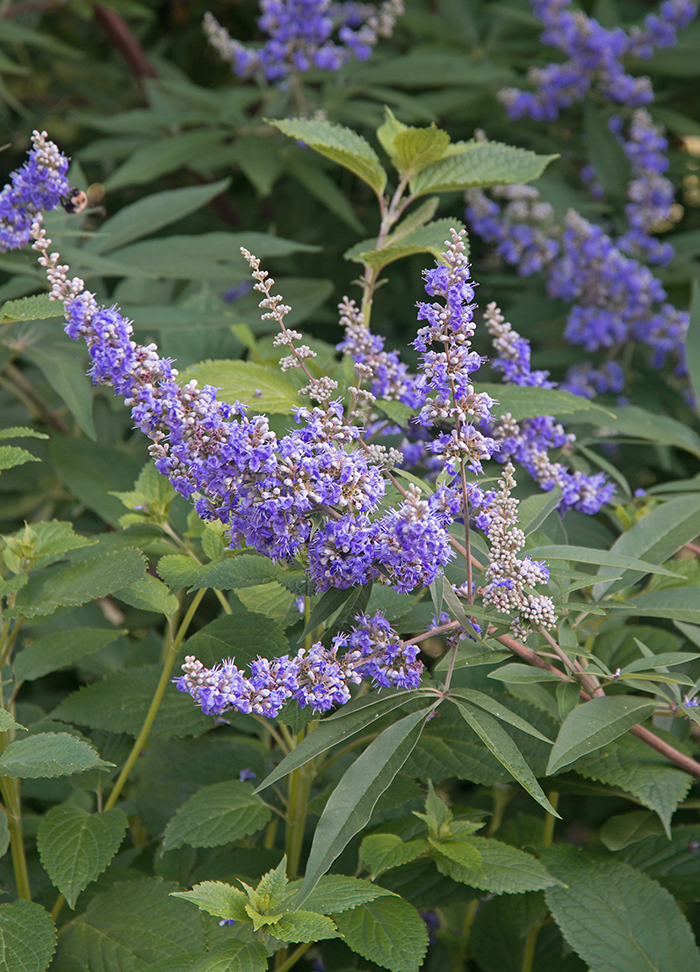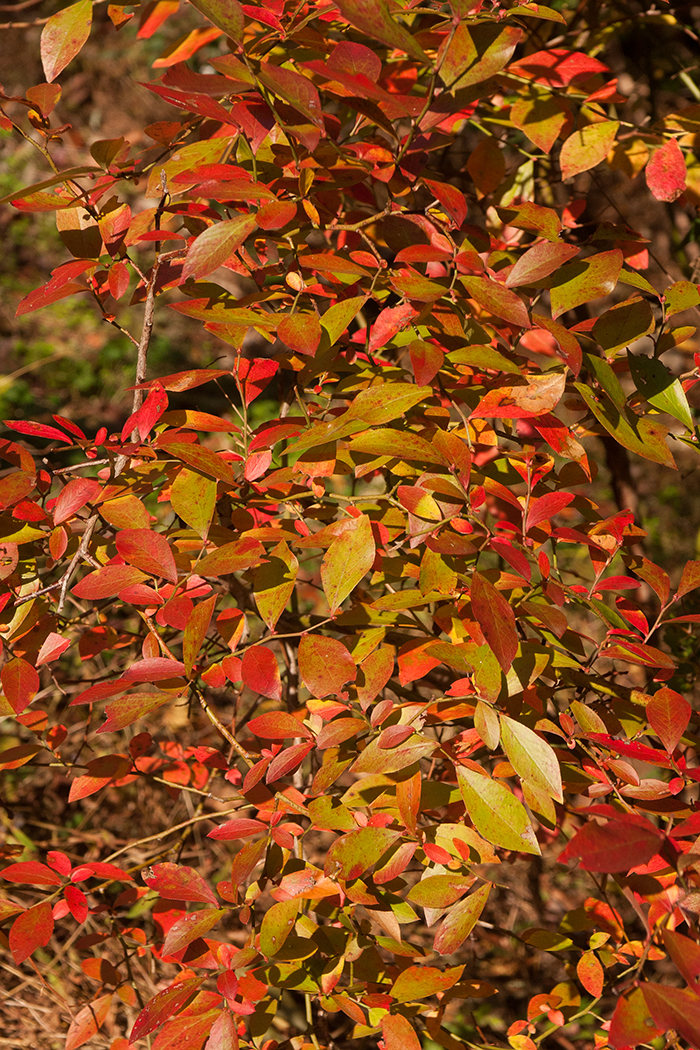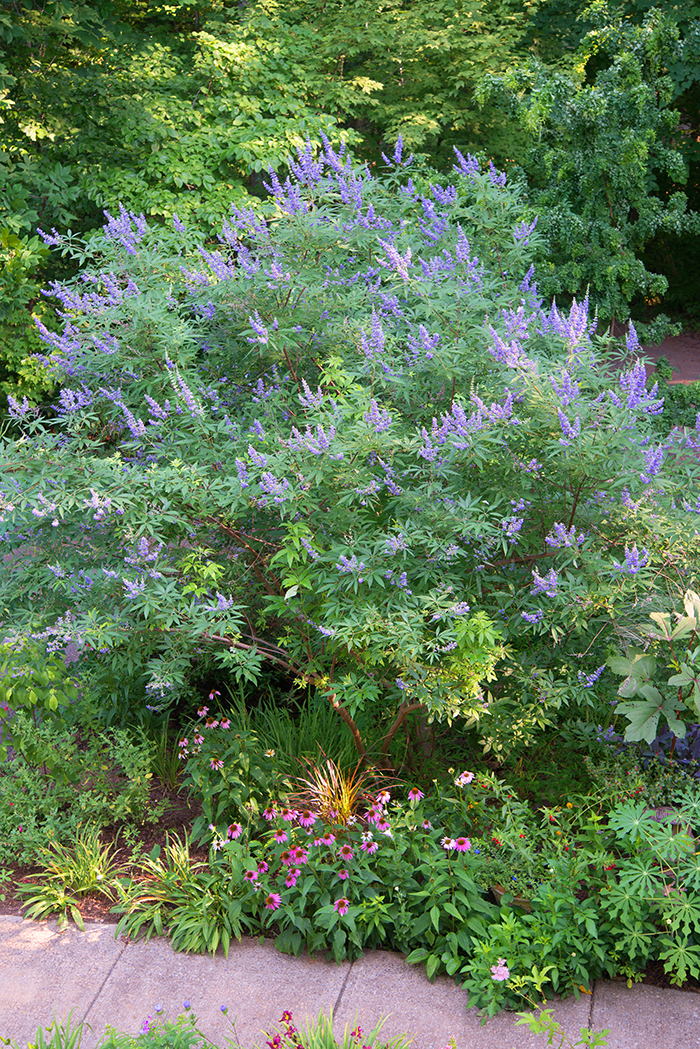With autumn arriving at garden gates this month, it will soon be a prime time to plant woody ornamentals. So, which trees or shrubs are you thinking about adding to your landscape?
It is obvious that crape myrtles are the go-to small trees/large shrubs that many local gardeners turn to for extended, dependable, colorful flowers during the growing season — they are everywhere! And while I’ll admit to admiring them myself more than a few times, there is a similar showoff that doesn’t get the same attention, but it should.
The pretty that has turned my head is vitex (Vitex agnus-castus), also called chaste tree. Following the same bloom timeline as crape myrtles, vitex starts the summer off generously bejeweled with sprite-like spikes of blossoms dipped in a gorgeous lavender-blue hue. More flowers will follow until the early fall, although at a lesser pace. Again, similar to crape myrtles.

Shoal Creek Vitex
Vitex is native to southern Europe and western Asia, but has found our region much to its liking. This deer-resistant pretty loves full sun and, once established, is quite drought-resistant. It is adaptable to most soil types — the exception being mucky, slow-draining areas, where it will suffer.
Not only is a flowering vitex pretty, but it can also be a busy hub of buzz in the summer. It is a major fly-in for bees and hummingbirds, because they find its lightly scented flowers simply irresistible. Ditto for butterflies.
Typical cultivars like the popular ‘Shoal Creek’ can normally stretch upwards to 15 feet or more, but more compact selections, such as ‘Blue Puffball’ (three feet tall) and ‘Blue Diddley’ (three to six feet tall) are available. While vitexes in general are not as commonly seen in nurseries as crape myrtles, they aren’t rare either and are certainly easy finds online.
Some cultivars sport white or pink flowers, but to me, they miss the magic that is a vitex full of blushing bluish blooms in the summer. However, it’s your garden and your choice.
If you want to prevent a standard vitex from reaching to the heavens, prune it. Since flowers form on new wood, this is best done in the late winter. Some years, I have really whacked my vitex back, but it has always rebounded with a bodacious bloom show, seeming to spite me.
The one bugaboo about vitex is that it can seed about the yard, which is not necessarily desirable. An easy way to solve this proclivity to procreate is to prune the blossoms as they begin to fade, preventing the formation of seed-bearing drupes. Cutting spent flowers off early in the growing season also has the plus of encouraging even more blooms later in the summer.

Autumn Blueberry Bush
One more woody ornamental to consider planting this fall — ready for a surprise? Blueberry bushes, in addition to providing tasty, nutritious treats, can be rather handsome landscape plants. Many become foliar blazes of fire during the autumn season, while their bell-shaped flowers pleasantly pop visually to ring in a new spring.
Blueberry bushes won’t be hard to find at area nurseries, but for just north of a ton of choices to pick from, Finch Blueberry Nursery (finchblueberrynursery.com) in Bailey, N.C., a short drive east of Raleigh off Highway 264, has one of the largest selections of blueberry cultivars in the Southeast. Finch is also an online retailer.
To Do in the Garden
September
- Herbaceous perennials will be bit to the ground by the coming frosts of autumn. Before they die back, mark their locations with plastic tags (cut up soda cups will work) so they won’t accidentally be dug up during next spring’s planting frenzy.
- Time for trading. Any pretty specimen plants that have become overcrowded, such as daylilies, bearded irises, hostas and peonies, can now be divided and swapped with other gardeners.
- Curb your fetish to fertilize evergreen perennials and woody ornamentals with high-nitrogen products now. September is not the time to encourage tender, new foliage growth, because the plants need to toughen up and prepare for the coming winter.
- Keep the bird feeder well stocked, because activity among your garden buddies on the wing will increase with the coming of fall. Also, continue cleaning out the bird bath and adding fresh water weekly.
- Woman of Western Wake: Anne Clem Whitaker
- Woman of Western Wake: Carla Mantilla
- Woman of Western Wake: Lisa Higginbotham
- Woman of Western Wake: Rev. Dr. Rose Cornelious
- Woman of Western Wake: Willa Brigham
- Presenting the 2020 Women of Western Wake
- Nonprofit Spotlight: Wade Edwards Learning Lab
- From the Editor: Making it Work Remotely
- News from the Home Office
- Restaurant Profile: The Peak on Salem
- Liquid Assets: Mort’s Trophy Lager from Trophy Brewing Co.
- Garden Adventurer: Vitex, the Other Summer Show







